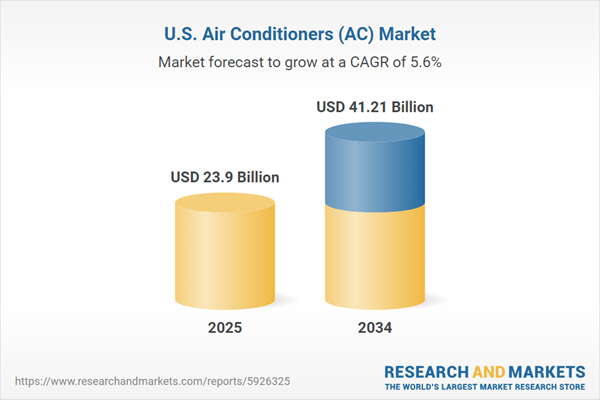Rising Use of Air Conditioners (AC) in the Residential and Commercial Sectors Augmenting the Market Growth
The extensive use of air conditioners (AC) in the residential, commercial, and industrial sectors is aiding the growth of the industry. With the rising temperature owing to rapid climate change, the demand for air conditioners in cooler regions like Oregon, Seattle, and Portland, among others, is significantly surging, hence fuelling the industry growth.
The growing demand for cost-effective air conditioners (AC) by the middle-and-low-income families in the United States is further bolstering the market growth. As extensive greenhouse gas emissions by air conditioners are emerging, which is one of the most critical issues, the development of energy-efficient and sustainable air conditioners (AC) is escalating, which is providing further impetus to the industry growth.
As the trend of installing connected devices is significantly growing, the demand for air conditioners (AC) that can be controlled through smartphones is increasing, hence augmenting the market growth. Moreover, smart air conditioners (AC) provide data regarding usage, energy consumption, and performance to enable efficient management and maintenance, which is propelling the industry growth. The growing preference for air conditioners (AC) with self-diagnosis features to boost cost-effectiveness and minimise downtime is significantly contributing to the growth of the market.
Air Conditioners (AC): Market Segmentation
Air conditioners (AC) are systems that control and monitor the temperature, humidity, and ventilation in enclosed spaces like vehicles or buildings. They maintain a cool atmosphere by removing the moisture and heat from enclosed spaces. Air conditioners also filter dust, pollen, and other allergens to boost the indoor air quality, due to which they are increasingly preferred.Market Breakup by Type
- Window AC
- Central AC
- Mini Split AC
- Others
Market Breakup by Size
- < 12K BTU
- 12K-36K BTU
- 36K-60K BTU
Market Breakup by End Use
- Commercial
- Residential
Market Breakup by Distribution Channel
- Hypermarket
- Electronic Stores
- Online
- Others
The growing integration of the latest technologies like 3D printing in the manufacturing of air conditioners (AC) is augmenting the growth of the industry. 3D printing can effectively customise the design of air conditioners (AC) in accordance with consumers’ preferences, which is expected to bolster their demand. Moreover, the use of 3D printing is anticipated to boost the cost-effectiveness and manufacturing time of air conditioners, which is estimated to drive the market growth in the forecast period.
The increasing research activities to boost the cost-effectiveness and energy-efficiency of air conditioners (AC) is expected to bolster the market growth. The use of environmentally friendly saline and thin membranes to boost the affordability of air conditioners (AC) is predicted to propel the industry growth. In addition, the utilisation of solar thermal energy as a power source for air conditioners (AC) to eliminate utility costs and boost their sustainability is anticipated to augment the market growth. Various researchers are increasingly attempting to develop cooling technologies that do not utilise water or air, which is anticipated to aid the growth of the market. The development of air conditioners (AC) that enhances the air quality of enclosed spaces in the wake of the COVID-19 pandemic is projected to propel the industry growth.
Key Industry Players in the United States Air Conditioners (AC) Market
The report presents a detailed analysis of the following key players in the United States air conditioners (AC) market, looking into their capacity, market shares, and latest developments like capacity expansions, plant turnarounds, and mergers and acquisitions:- Nortek
- AB Electrolux
- LG Electronics
- DAIKIN INDUSTRIES, Ltd.
- Fujitsu General Limited
- Johnson Controls
- Others
Table of Contents
Companies Mentioned
The key companies featured in this United States Air Conditioners (AC) market report include:- Nortek
- AB Electrolux
- LG Electronics
- DAIKIN INDUSTRIES, Ltd.,
- Fujitsu General Limited
- Johnson Controls
Table Information
| Report Attribute | Details |
|---|---|
| No. of Pages | 128 |
| Published | August 2025 |
| Forecast Period | 2025 - 2034 |
| Estimated Market Value ( USD | $ 23.9 Billion |
| Forecasted Market Value ( USD | $ 41.21 Billion |
| Compound Annual Growth Rate | 5.6% |
| Regions Covered | United States |
| No. of Companies Mentioned | 7 |









